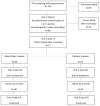Randomised clinical trial: mixed soluble/insoluble fibre vs. psyllium for chronic constipation
- PMID: 27125883
- PMCID: PMC4891216
- DOI: 10.1111/apt.13647
Randomised clinical trial: mixed soluble/insoluble fibre vs. psyllium for chronic constipation
Abstract
Background: Fibre supplements are useful, but whether a plum-derived mixed fibre that contains both soluble and insoluble fibre improves constipation is unknown.
Aim: To investigate the efficacy and tolerability of mixed soluble/insoluble fibre vs. psyllium in a randomized double-blind controlled trial.
Methods: Constipated patients (Rome III) received mixed fibre or psyllium, 5 g b.d., for 4 weeks. Daily symptoms and stool habit were assessed using stool diary. Subjects with ≥1 complete spontaneous bowel movement/week above baseline for ≥2/4 weeks were considered responders. Secondary outcome measures included stool consistency, bowel satisfaction, straining, gas, bloating, taste, dissolvability and quality of life (QoL).
Results: Seventy-two subjects (mixed fibre = 40; psyllium = 32) were enrolled and two from psyllium group withdrew. The mean complete spontaneous bowel movement/week increased with both mixed fibre (P < 0.0001) and psyllium (P = 0.0002) without group difference. There were 30 (75%) responders with mixed fibre and 24 (75%) with psyllium (P = 0.9). Stool consistency increased (P = 0.04), straining (P = 0.006) and bloating scores decreased (P = 0.02) without group differences. Significantly more patients reported improvement in flatulence (53% vs. 25%, P = 0.01) and felt that mixed fibre dissolved better (P = 0.02) compared to psyllium. QoL improved (P = 0.0125) with both treatments without group differences.
Conclusions: Mixed fibre and psyllium were equally efficacious in improving constipation and QoL. Mixed fibre was more effective in relieving flatulence, bloating and dissolved better. Mixed fibre is effective and well tolerated.
© 2016 John Wiley & Sons Ltd.
Conflict of interest statement
Figures
Comment in
-
Editorial: mixed soluble fibre in chronic constipation - something new?Aliment Pharmacol Ther. 2016 Aug;44(3):302-3. doi: 10.1111/apt.13685. Aliment Pharmacol Ther. 2016. PMID: 27375095 No abstract available.
-
Editorial: mixed soluble fibre in chronic constipation - something new? Authors' reply.Aliment Pharmacol Ther. 2016 Aug;44(3):303. doi: 10.1111/apt.13688. Aliment Pharmacol Ther. 2016. PMID: 27375096 No abstract available.
References
-
- Higgins PD, Johanson JF. Epidemiology of constipation in North America: a systematic review. Am J Gastroenterol. 2004;99:750–9. - PubMed
-
- Rey E, Balboa A, Mearin F. Chronic constipation, irritable bowel syndrome with constipation and constipation with pain/discomfort: similarities and differences. Am J Gastroenterol. 2014;109:876–84. - PubMed
-
- Johanson JF, Kralstein J. Chronic constipation: a survey of the patient perspective. Aliment Pharmacol Ther. 2007;25:599–608. - PubMed
-
- Bharucha AE, Dorn SD, et al. American Gastroenterological Association medical position statement on constipation. Gastroenterology. 2013;144:211–7. - PubMed
Publication types
MeSH terms
Substances
Grants and funding
LinkOut - more resources
Full Text Sources
Other Literature Sources
Medical



